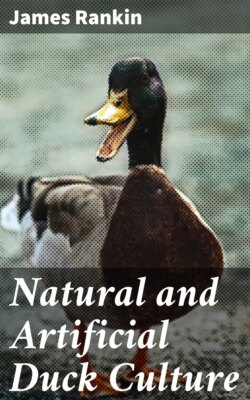Читать книгу Natural and Artificial Duck Culture - James Rankin - Страница 24
На сайте Литреса книга снята с продажи.
Feathers are Pure White.
ОглавлениеTable of Contents
Another advantage of the Pekin over the other breeds is their pure white, elastic feathers which are largely mixed with down. These feathers readily command from forty to fifty cents per pound, and as the reader can see, are no mean source of income, especially when the birds are grown in large numbers. These birds, as their name indicates, originated in China. They are large, beautiful birds, of a proud, erect carriage, with pure white plumage outside. The inside feathers are slightly cream colored. The neck is long and gracefully curved; the head long and finely shaped, with a full bright eye. The legs and beak are of a very dark orange, and form a fine contrast to the pure white feathers. The minimum weight of our birds when matured is about fourteen pounds per pair, while the very heaviest will tip the scales at twenty-two pounds. My first experience with ducks commenced more than forty years ago. We used the common puddle ducks and grew them for the city market. The ducks were very small and so were the profits. They were fed but little and allowed full range, consequently the home ties were not strong.
Those ducks followed the little brook in the pasture through swamps and marshes for half a mile in either direction, wholly regardless of farm limits. If we expected any eggs from those ducks they should have been safely housed at night. This task devolved upon the boys. Now our paternal head, though a kind and indulgent parent (unfortunately for us), had the impression that boys were made to work, and work we did. Now, what boy of ten or twelve years had not rather chase ducks through the mud in the swamp than to wield the hoe among the weeds in the corn field? It was our recreation, our chief solace and delight through those long, hot summer days—the anticipation of that duck hunt in the evening. I think our extraordinary love for the duck hailed from this date. Later on we used a cross between a Rouen and Cayuga. This cross made a much larger and better market bird. The flesh was better flavored. They produced more eggs and began earlier in the spring, consequently prices and profits slightly improved.
These birds did not stray as far, but were as fond of mud and water as their little predecessors. It was a pleasing and comical sight to see three or four hundred of these ducklings of all ages, when first let out in the morning, run down the hill in their eager haste to reach the swamp, a part of them right side up, then rolling over and over on their broadsides; others still reversing themselves end for end down the steep incline, apparently a matter of supreme indifference how, so long as they reached the mud first.
These ducklings always returned at night with their numbers more or less depleted, as they were the legitimate prey of skunks, minks, weasels and mud turtles; and if we reached the summer's end with sixty per cent. of the original number we were well satisfied. All this has been changed. We have learned a number of points on duck culture since then. First, that all losses by vermin can be easily avoided by yarding your little birds at home and keeping them under your own eye. Second, that mud and water externally applied are not essential to their growth and well-being, and that in fact they will thrive better without.
